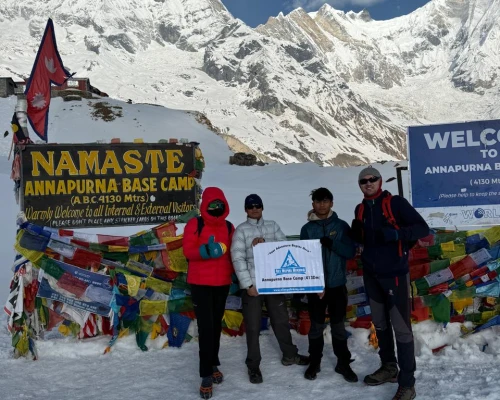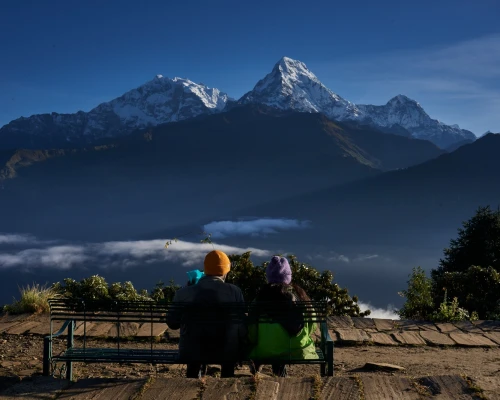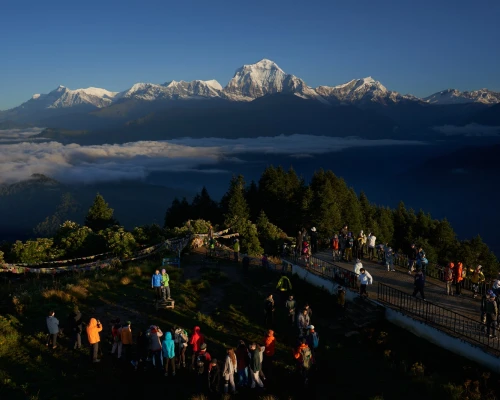The Annapurna Base Camp Trek 15 days is renowned as one of the world's most breathtaking hiking routes, a journey that will undoubtedly make your visit to Nepal truly memorable. This trek encompasses three of the most popular trekking destinations: Annapurna Base Camp, Annapurna Circuit, and the Ghorepani PoonHill Trek. It offers a captivating fusion of nature and culture within the Annapurna Region, where lush oak, rhododendron, and pine forests complement the rich cultural traditions of the Gurung and Magar communities.
Commencing in Nayapul and leading to Ghorepani, this Annapurna Base Camp Trek is renowned for its stunning vistas of Annapurna (8,091m), Fishtail (6,993m), and Dhaulagiri (8,167m), as well as its mesmerizing landscapes and the timeless Gurung culture. The trail meanders through a river valley, gradually narrowing before revealing the grandeur of the surrounding mountains. While many treks offer panoramic views, this journey focuses on reaching the very base of these majestic Himalayan peaks. Key highlights of this trek include Ghorepani, Poonhill, Jhino Danda, Machhapuchhre Base Camp, and Annapurna Base Camp. The Annapurna massif and adjacent peaks, such as Himchuli, Manasalu, Ganesh Himal, and others, grace the trek with their stunning presence. Moreover, the trek takes place within the captivating Annapurna Conservation Area, making it a truly enriching experience.
How difficult is the Annapurna Base Camp Trek - 15 Days?
The difficulty of the Annapurna Base Camp Trek is a topic of much discussion among trekkers planning their journey to this iconic destination. In comparison to other treks in Nepal, such as the Everest Base Camp Trek and Manaslu Trek, the Annapurna Base Camp Trek is generally considered less challenging. However, the level of difficulty can vary depending on factors such as your age and prior trekking experience.
For beginners and those who have not trekked at high altitudes extensively, the Annapurna Base Camp Trek is often seen as an ideal choice. One of its advantages is that it does not take trekkers above 5,000 meters, which can help mitigate some of the risks associated with extreme altitude.
Nonetheless, the trek can still pose challenges, particularly for individuals with weak stamina or older trekkers. On average, trekkers can expect to walk for 4 to 7 hours a day, with breaks for tea, snacks, and lunch along the way. The terrain involves a mix of ascents and descents, and as you ascend to higher altitudes, the air becomes thinner, potentially causing fatigue and breathlessness.
The difficulty of the trek can also be influenced by factors like the duration and distance of the trip, the possibility of altitude sickness, your level of physical preparedness, and the trekking season. Altitude sickness, in particular, can be a concern, but with proper acclimatization and a well-planned itinerary, it can be managed.
In summary, while the Annapurna Base Camp Trek may not be a walk in the park, it is generally considered a moderately challenging trek. With determination, reasonable fitness levels, and the right mental attitude, most trekkers can complete this journey, making it a rewarding and achievable adventure amidst the stunning landscapes of the Annapurna region.
Best Season for Annapurna Base Camp Trek -15 Days
The Annapurna Base Camp Trek can be undertaken throughout the year, but the choice of season significantly impacts the experience. For a quieter and less crowded trek, the summer or monsoon season (June, July, and August) is an option, although it requires thorough preparation. During this period, temperatures range from 19°C to 4°C, resulting in hazy conditions from the sun and heavy rainfall.
However, for the best overall experience in terms of weather and natural beauty, autumn (fall) and spring are recommended. In these seasons, which typically run from September to November and March to May, respectively, the weather is favorable with average temperatures ranging from 12°C to 21°C. The trekking trails are neither excessively wet nor slippery, and the days are long and warm, while nights are cooler. The brighter days provide excellent opportunities to enjoy the lush green fields and witness the diverse flora and fauna along the trails.
Conversely, the winter months of December to February are characterized by drastic weather changes in the Annapurna Base Camp trekking region. Temperatures plummet to between 9.3°C and -20°C, resulting in extremely cold and challenging conditions for trekking. This time of year is generally not preferred by most trekkers due to the harsh weather.
In essence, while the Annapurna Base Camp Trek can be undertaken year-round, autumn and spring are the preferred seasons, offering the best combination of pleasant weather and stunning natural landscapes. The summer and monsoon seasons can be an option for those seeking solitude, while the winter months pose considerable challenges and are less favored by trekkers.
Meals and Accommodation During Annapurna Base Camp Trek - 15 Days
Throughout the 15-day Annapurna Base Camp Trek, trekkers can rely on meals and accommodations provided by teahouses or lodges situated along the trekking route. Teahouses offer a functional yet comfortable lodging experience, typically featuring clean rooms with twin beds and bedding. In most cases, bathroom facilities are shared. While some teahouses may offer private rooms for an additional cost, they are limited in availability.
In terms of meals, teahouses provide a varied menu. Breakfast options encompass items like Tibetan bread, omelets, porridge, pancakes, muesli, and tea or coffee. Lunch selections include dal bhat (a traditional Nepali dish consisting of rice and lentil soup), fried rice, noodles, sandwiches, momo (dumplings), and a range of international dishes. Dinner offerings are equally diverse, with choices like dal bhat, pasta, pizza, meat, and vegetable dishes. Additionally, teahouses may present a selection of soups and desserts.
Trekkers also have the option to purchase snacks such as chocolate bars, nuts, chips, and bottled water at these lodges. While the teahouses offer the necessary amenities for a comfortable trek, it's important to note that the facilities become more basic as you ascend to higher altitudes. Depending on the elevation, you may encounter the opportunity for hot showers and charging facilities for electronic devices, though these services often come at an extra charge. Teahouses in higher-altitude regions may also provide heating stoves or blankets to combat the cold, particularly during the winter months.
Given the extended duration of the 15-day trek, it's essential to prepare for changing weather conditions by carrying extra layers of clothing and ensuring you have everything needed for a safe and comfortable journey. While teahouses provide essential services, it's important to approach the trek with the expectation of basic facilities rather than luxury accommodations. Booking accommodations in advance, particularly during peak trekking seasons, is advisable to secure your lodging along the route.
Permits Required During Annapurna Base Camp Trek - 15 Days
For the 15-day Annapurna Base Camp Trek in Nepal, several permits are required to ensure that you are trekking legally and contributing to conservation efforts in the area. Here are the key permits you need:
Annapurna Conservation Area Permit (ACAP): This permit is essential for all trekkers entering the Annapurna Conservation Area, which includes the Annapurna Base Camp region. It helps fund conservation and maintenance efforts in the area. The cost of the ACAP permit varies for foreigners, with different rates for SAARC (South Asian Association for Regional Cooperation) nationals and non-SAARC nationals.
Trekkers' Information Management System (TIMS) Card: The requirement for TIMS cards for trekkers in the Annapurna region was under review as of my last knowledge update in September 2021. Some treks no longer required them, while others still did. It's crucial to check the most current regulations with the Nepal Tourism Board or your trekking agency to confirm whether you need a TIMS card for the Annapurna Base Camp Trek.






